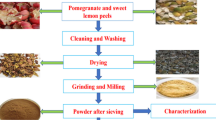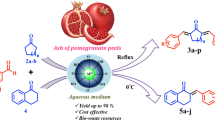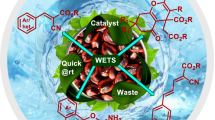Abstract
Globally, each day a huge amount of agro-wastes (AWs) have been generated in attending to the demands of the rapidly growing population. The invention of technologies or methods by employing AWs in the synthesis of biologically significant chemical substances seems to be a logical solution to the world’s most desired areas of research, environment and health. Herein, we report a sustainable and (agro)waste valorization method for the construction of quinoxalines from α-bromo ketones and aromatic 1,2-diamines using water extract of pomegranate peel ash (WEPA). The developed reactions can be carried out in room temperature using biorenewable WEPA as catalyst as well as aqueous reaction media. It avoids the environment toxic/problematic/volatile organic solvents throughout the procedure from synthesis to purification. The products are purified by recrystallization, and the reactions are conducted under external non-renewable catalyst-free conditions. The freshly prepared WEPA was also characterized by using powdered X-ray diffraction, Fourier transform infrared spectroscopy, scanning electron microscopy and energy-dispersive X-ray analyses. The first use of biorenewable aqueous extract for the quinoxalines synthesis, effective applicability of organic solid waste, ambient conditions, and avoid of depleting resources originated substances as reaction media/catalyst/purification or work-up agents/promoters/heating conditions are the significant attributes of this investigation. Therefore, this research may attract researcher's attention towards studying the waste-derived ashes in the materials as well as in synthetic chemistry.


Similar content being viewed by others
Data availability
All data generated or analysed during this study are included in this published article and its supplementary information files.
References
Abelenda AM, Semple KT, Lag-Brotons AJ, Herbert BMJ, Aggidis G, Aiouache F (2021) Efects of wood ash-based alkaline treatment on nitrogen, carbon, and phosphorus availability in food waste and agro-industrial waste digestates. Waste Biomass Valor 12:3355–3370
Appa RM, Lakshmidevi J, Naidu BR, Venkateswarlu K (2021a) Pd-catalyzed oxidative homocoupling of arylboronic acids in WEPA: A sustainable access to symmetrical biaryls under added base and ligand-free ambient conditions. Mol Catal 501:111366
Appa RM, Naidu BR, Venkateswarlu D, Hanafiah MM, Lakkaboyana SK, Lakshmidevi J, Venkateswarlu K (2021b) Water extract of pomegranate ash–I2 as sustainable system for external oxidant/metal/catalyst-free oxidative iodination of (hetero)arenes. Green Chem Lett Rev 14:710–722
Ashish P, Drashti S, Naiya P, Khushbu P, Nidhi S, Afzal N, Umang S, Mehul P, Swayamprakash P, Bhargav B, Tushar B (2021) Quinoxaline as ubiquitous structural fragment: an update on the recent development of its green synthetic approaches. Curr Org Chem 25:3004–3016
Athira VS, Charitha V, Athira G, Bahurudeen A (2021) Agro-waste ash based alkali-activated binder: cleaner production of zero cement concrete for construction. J Clean Prod 286:125429
Baghbanian SM (2015) Propylsulfonic acid functionalized nanozeolite clinoptilolite as heterogeneous catalyst for the synthesis of quinoxaline derivatives. Chin Chem Lett 26:1113–1116
Bhargava S, Soni P, Rathore D (2019) An environmentally benign attribute for the expeditious synthesis of quinoxaline and its derivatives. J Mol Stru 1198:126758
Bhomick PC, Supong A, Baruah M, Pongener C, Gogoi C, Sinha D (2020) Alizarin red S adsorption onto biomass-based activated carbon: optimization of adsorption process parameters using Taguchi experimental design. Int J Environ Sci Technol 17:1137–1148
Biesen L, Müller TJJ (2021) Multicomponent and one-pot syntheses of quinoxalines. Adv Synth Catal 363:980–1006
Borah B, Chowhan LR (2021) Recent advances in the transition-metal-free synthesis of quinoxalines. RSC Adv 11:37325–37353
Chan CCV, Lari K, Soulsbury K (2020) An intermittently operated biochar filter to remove chemical contaminants from drinking water. Int J Environ Sci Technol 17:3119–3130
Das B, Venkateswarlu K, Suneel K, Majhi A (2007) An efficient and convenient protocol for the synthesis of quinoxalines and dihydropyrazines via cyclization–oxidation processes using HClO4·SiO2 as a heterogeneous recyclable catalyst. Tetrahedron Lett 48:5371–5374
Desa UN (2019) World population prospects 2019: highlights. New York NY United Nations Dep Econ Social Affairs 11:125
Foo KY, Hameed BH (2009) Value-added utilization of oil palm ash: a superior recycling of the industrial agricultural waste. J Hazard Mater 172:523–531
Ghosh P, Mandal A (2013) Sodium dodecyl sulfate in water: greener approach for the synthesis of quinoxaline derivatives. Green Chem Lett Rev 6:45–54
Ghosh P, Mandal A, Subba R (2013) γ-Maghemite-silica nanocomposite: a green catalyst for diverse aromatic N-heterocycles. Catal Commun 41:146–152
Harsha KB, Rangappa KS (2016) One-pot approach for the synthesis of functionalized quinoxalines mediated by T3P®-DMSO or T3P® via a tandem oxidation-condensation or condensation reaction. RSC Adv 6:57154–57162
Harsha KB, Rangappa S, Preetham HD, Swaroop TR, Gilandoust M, Rakesh KS, Rangappa KS (2018) An easy and efficient method for the synthesis of quinoxalines using recyclable and heterogeneous nanomagnetic-supported acid catalyst under solvent-free condition. ChemistrySelect 3:5228–5232
Hebade MJ, Deshmukh TR, Dhumal ST (2021) Silica supported dodecatungstophosphoric acid (DTP/SiO2): an efficient and recyclable heterogeneous catalyst for rapid synthesis of quinoxalines. Synth Commun 51:2510–2520
Hossain SKS, Mathur L, Roy PK (2018) Rice husk/rice husk ash as an alternative source of silica in ceramics: a review. J Asian Ceram Soc 6:299–313
Hsini N, Abdelwaheb M, Dhaouadi H, Dridi-Dhaouadi S (2020) Valorization of solid wastes from Dittrichia essential oil extraction as biosorbents for cadmium removal: biosorbent characterizations and isotherm modeling. Int J Environ Sci Technol 17:4611–4622
Hui KS, Chao CYH (2006) Pure, single phase, high crystalline, chamfered-edge zeolite 4A synthesized from coal fly ash for use as a builder in detergents. J Hazard Mater 137:401–409
Jeganathan M, Dhakshinamoorthy A, Pitchumani K (2014) One-pot synthesis of 2-substituted quinoxaline using K10-montmorillonite as heterogeneous catalyst. Tetrahedron Lett 55:1616–1620
Kaab A, Sharifi M, Mobli H, Nabavi-Pelesaraei A, Chau KW (2019) Combined lifecycle assessment and artificial intelligence for prediction of output energy and environmental impacts of sugarcane production. Sci Total Environ 664:1005–1019
Kaushal T, Srivastava G, Sharma A, Negi AS (2019) An insight into medicinal chemistry of anticancer quinoxalines. Bioorg Med Chem 27:16–35
Khalafy J, Habashi BP, Marjani AP, Moghadam PN (2012) The synthesis of 2-arylquinoxaline derivatives. Curr Chem Lett 1:139–146
Koul B, Yakoob M, Shah MP (2022) Agriculture waste management strategies for environmental sustainability. Environ Res 206:112285
Kühlborn J, Groß J, Opatz T (2020) Making natural products from renewable feedstocks: back to the roots? Nat Prod Rep 37:380–424
Kumar A, Dhameliya TM, Sharma K, Patel KA, Hirani RV, Bhatt AJ (2022) Sustainable approaches towards the synthesis of quinoxalines: an update. J Mol Struct 1259:132732
Lakshmidevi J, Appa RM, Naidu BR, Prasad SS, Sarma LS, Venkateswarlu K (2018) WEPA: a bio-derived medium for added base, π-acid and ligand free Ullmann coupling of aryl halides using Pd(OAc)2. Chem Commun 54:12333–12336
Lakshmidevi J, Naidu BR, Reddy SSS, Venkateswarlu K (2022a) Oxidative iododeborylation reaction of (hetero)arylboronic acids in water extract of pomegranate ash: a novel and sustainable synthesis of iodo(hetero)arenes. Waste Biomass Valor 13:2207–2216
Lakshmidevi J, Naidu BR, Venkateswarlu K (2022b) CuI in biorenewable basic medium: three novel and low E-factor Suzuki-Miyaura cross-coupling reactions. Mol Catal 522:112237
Lian M, Li Q, Zhu Y, Yin G, Wu A (2012) Logic design and synthesis of quinoxalines via the integration of iodination/oxidation/cyclization sequences from ketones and 1,2-diamines. Tetrahedron 68:9598–9605
Madhav B, Murthy SN, Reddy VP, Rao KR, Nageswar YVD (2009) Biomimetic synthesis of quinoxalines in water. Tetrahedron Lett 50:6025–6028
Maikhuri VK, Prasad AK, Jha A, Srivastava S (2021) Recent advances in the transition metal catalyzed synthesis of quinoxalines: a review. New J Chem 45:13214–13246
Mariscal R, Maireles-Torres P, Ojeda M, Sádaba I, Granados ML (2016) Furfural: a renewable and versatile platform molecule for the synthesis of chemicals and fuels. Energy Environ Sci 9:1144–1189
Meshram SU, Khandekar UR, Mane SM, Mohan A (2015) Novel route of producing zeolite a resin for quality-improved detergents. J Surfact Deterg 18:259–266
Nageswar YVD, Reddy KHV, Ramesh K, Murthy SN (2013) Recent developments in the synthesis of quinoxaline derivatives by green synthetic approaches. Org Prep Proc Int 45:1–27
Naidu BR, Venkateswarlu K (2022) WEPA: a reusable waste biomass-derived catalyst for external oxidant/metal-free quinoxaline synthesis via tandem condensation–cyclization–oxidation of α-hydroxy ketones. Green Chem 24:6215–6223
Naidu BR, Lakshmidevi J, Naik BSS, Venkateswarlu K (2021) Water extract of pomegranate ash as waste-originated biorenewable catalyst for the novel synthesis of chiral tert-butanesulfinyl aldimines in water. Mol Catal 511:111719
Naidu BR, Lakshmidevi J, Venkateswarlu K, Lakkaboyana SK (2022) Highly economic and waste valorization strategy for multicomponent and Knoevenagel reactions using water extract of tamarind seed ash. Environ Sci Pollut Res. https://doi.org/10.1007/s11356-022-20124-1
Natte K, Narani A, Goyal V, Sarki N, Jagadeesh RV (2020) Synthesis of functional chemicals from lignin-derived monomers by selective organic transformations. Adv Synth Catal 362:5143–5169
Oladipo B, Ojumu TV, Latinwo LM, Betiku E (2020) Pawpaw (Carica papaya) peel waste as a novel green heterogeneous catalyst for moringa oil methyl esters synthesis: process optimization and kinetic study. Energies 13:5834
Pogula J, Laha S, Likhar PR (2017) Nano copper(0)-stabilized on alumina: efficient and recyclable heterogeneous catalyst for chemoselective synthesis of 1,2-disubstituted benzimidazoles and quinoxalines in aqueous medium. Catal Lett 147:2724–2735
Sarmah B, Srivastava R (2017) Sustainable catalyst process with a high eco-scale score for the synthesis of five-, six-, and seven-membered heterocyclic compounds using nanocrystalline zeolites. Asian J Org Chem 6:873–889
Sharma G, Kaur M, Punj S, Singh K (2020) Biomass as a sustainable resource for value-added modern materials: a review. Biofuels Bioprod Biorefin 14:673–695
Shitre PV, Harale RR, Sathe BR, Shingare MS (2017) Silica nanosphere-graphene oxide (SiO2-GO) hybrid catalyzed facile synthesis of functionalized quinoxaline derivatives. Res Chem Intermed 43:829–841
Singh S, Mishra P, Srivastava M, Singh SB, Singh J, Tiwari KP (2012) N-heterocyclic carbene (thiamine) promoted eco-friendly synthesis of quinoxalines under mild reaction conditions. Green Chem Lett Rev 5:587–593
Sivalingam S, Sen S (2020) Rice husk ash derived nanocrystalline ZSM-5 for highly efficient removal of a toxic textile dye. J Mater Res Technol 9:14853–14864
Tanwar B, Purohit P, Raju BN, Kumar D, Kommi DN, Chakraborti AK (2015) An “all-water” strategy for regiocontrolled synthesis of 2-aryl quinoxalines. RSC Adv 5:11873–11883
Taylor EC, Cheeseman GWH (1964) Synthesis and properties of pyrrolo (1,2-a) quinoxalines. J Am Chem Soc 86:1830–1835
Tiwari S, Pradhan MK (2017) Effect of rice husk ash on properties of aluminium alloys: a review. Mater Today Proc 4:486–495
Tripathi N, Hills CD, Singh RS, Atkinson CJ (2019) Biomass waste utilisation in low-carbon products, harnessing a major potential resource. npj Clim Atmos Sci 2:35
Venkateswarlu K (2021) Ashes from organic waste as reagents in synthetic chemistry: a review. Environ Chem Let 19:3887–3950
Wan J-P, Gan S-F, Wu J-M, Pan Y (2009) Water mediated chemoselective synthesis of 1,2-disubstituted benzimidazoles using o-phenylenediamine and the extended synthesis of quinoxalines. Green Chem 11:1633–1637
Wang F, Cheng Z, Reisner A, Liu Y (2018) Compliance with household solid waste management in rural villages in developing countries. J Clean Prod 202:293–298
Wu M, Sun M, Zhou H, Ma J-Y, Ma T (2020) Carbon counter electrodes in dye-sensitized and perovskite solar cells. Adv Funct Mater 30:1906451
Xie F, Zhang M, Jiang H, Chen M, Lv W, Zheng A, Jian X (2015) Efficient synthesis of quinoxalines from 2-nitroanilines and vicinal diols via a ruthenium-catalyzed hydrogen transfer strategy. Green Chem 17:279–284
Yashwantrao G, Saha S (2021) Recent advances in the synthesis and reactivity of quinoxaline. Org Chem Front 8:2820–2862
Acknowledgements
BRN thanks Council of Scientific and Industrial Research (CSIR), New Delhi, for fellowship (No. 09/1076(0003)/2018-EMR-I).
Funding
Authors thanks Science and Engineering Research Board (SERB), New Delhi, for the financial support via the Grant No. SB/FT/CS-009/2014. Council of Scientific and Industrial Research (IN), 09/1076(0003)/2018-EMR-I, Bandameeda Ramesh Naidu.
Author information
Authors and Affiliations
Contributions
K Venkateswarlu designed and supervised the work presented in the current article, and BR Naidu performed the experiments. K Venkateswarlu and BR Naidu analysed the data, drafted, edited and approved.
Corresponding author
Ethics declarations
Conflict of interest
The authors declare that they have no competing interests.
Ethical approval
This manuscript does not contain the studies with human participants or animals performed by any of the others.
Additional information
Editorial responsibility: Ta Yeong Wu.
Supplementary Information
Below is the link to the electronic supplementary material.
Rights and permissions
Springer Nature or its licensor (e.g. a society or other partner) holds exclusive rights to this article under a publishing agreement with the author(s) or other rightsholder(s); author self-archiving of the accepted manuscript version of this article is solely governed by the terms of such publishing agreement and applicable law.
About this article
Cite this article
Ramesh Naidu, B., Venkateswarlu, K. A first novel and waste valorization route for the preparation of biologically significant quinoxalines using pomegranate peel ash extract. Int. J. Environ. Sci. Technol. 20, 13685–13694 (2023). https://doi.org/10.1007/s13762-022-04711-w
Received:
Revised:
Accepted:
Published:
Issue Date:
DOI: https://doi.org/10.1007/s13762-022-04711-w




